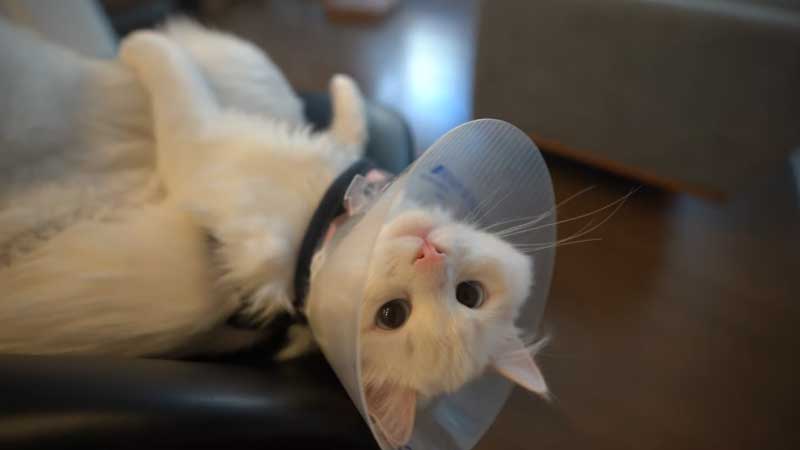Sometimes, you notice something unexpected and slightly disturbing: tiny bugs floating in your cat’s water fountain. This naturally begs the question, “Are tiny bugs in cat water fountain harmful?“
In most cases, the tiny bugs found in cat water fountains are harmless. However, their consistent presence and certain types of bugs can indicate water contamination or other issues that might be of concern. Regular cleaning and maintenance are the best preventive measures.
After all, the health and well-being of our cats are paramount. Stick around as we dive deep into this topic, ensuring you’re prepared with all the information you need to ensure your cat remains healthy and hydrated.
Table of Contents
Are Tiny Bugs in Cat Water Fountain Harmful? Common Types of Bugs Found in Cat Water Fountains

Water fountains for cats, as refreshing and beneficial as they are, can sometimes become a magnet for little bugs. Understanding what these bugs are and whether or not they pose any threat is essential for every cat parent. Here, we provide an overview of the most common bugs you might encounter in your cat’s water fountain.
Quick Guide to Identifying Bugs in Your Cat’s Water Fountain
| Bug Type | Appearance | Common Regions |
|---|---|---|
| Gnats | Small, dark, fly-like pests | Worldwide |
| Mosquito larvae | Tiny, wiggly worms | Worldwide, especially in warmer climates |
| Water fleas (Daphnia) | Tiny crustaceans with a jerky motion | Freshwater environments worldwide |
| Springtails | Tiny, white/translucent, often jumping | Humid regions worldwide |
| Mites | Tiny, spider-like with eight legs | Worldwide |
Overview of the Different Bugs One Might Find
- Gnats: These are small, dark, fly-like pests that are often drawn to stagnant water. They don’t harm the water, but their consistent presence might indicate that the water isn’t circulating as it should.
- Mosquito larvae: Resembling tiny wiggling worms, these are immature stages of mosquitoes. They thrive in stagnant water and are a clear sign that the water needs to be changed more frequently.
- Water fleas (Daphnia): These tiny crustaceans are common in freshwater environments. They are harmless and can even serve as food for some fish, but their presence may suggest the water has been sitting for a while.
- Springtails: Small, often white or translucent bugs that can sometimes be found in water. They are generally harmless but can be a nuisance if they proliferate.
- Mites: Tiny, spider-like creatures that might occasionally venture into water. They’re generally not a cause for concern when it comes to the water’s cleanliness but they can be annoying in large numbers.
Remember, while many of these bugs are harmless, their consistent presence can be an indication that your cat’s water fountain needs more regular maintenance or that there may be issues with the water circulation or cleanliness.
Read Also: Drain Fly Larvae in Cat Water Fountain
The Health Implications of Small Bugs in Cat Water Fountains
While a sip of water with an unexpected guest might make us humans grimace, our feline friends might not always be as disturbed. But should they be? Let’s explore the potential health implications for cats when tiny bugs decide to take a dip in their drinking fountains.
General Risks Associated with Ingesting Bugs
- Digestive Discomfort: Just as some people may experience mild upset stomachs after eating unfamiliar foods, cats may have short-term digestive discomfort after ingesting a significant number of bugs.
- Allergic Reactions: While rare, cats can have allergic reactions to certain bugs, which can manifest as skin irritations, itchiness, or respiratory issues.
- Choking Hazard: Extremely tiny bugs might not pose this risk, but larger bugs could potentially become a choking hazard, especially for kittens.
- Contamination: Bugs can sometimes carry bacteria or parasites. While the risk is relatively low, it’s a possibility that cat owners should be aware of.
- Specific Risks Related to Certain Bug Types
- Mosquito larvae: Once matured into mosquitoes, certain species can transmit heartworm disease. While the larvae themselves don’t directly cause the disease, a surrounding with many larvae indicates the presence of adult mosquitoes.
- Mites: Some mites can cause skin irritations or transmit parasites, though the mites commonly found in water are usually not of this variety.
- Springtails and Water Fleas: These are generally harmless to cats. In fact, in some environments, they might even serve as a source of nutrition.
Bug Type vs. Potential Health Risk: Informational Chart
| Bug Type | Potential Health Risk |
|---|---|
| Gnats | Minimal – mostly digestive discomfort if consumed in large numbers |
| Mosquito larvae | Indirect – presence indicates potential risk of adult mosquitoes and heartworm disease |
| Water fleas (Daphnia) | Minimal – generally considered safe |
| Springtails | Minimal – generally considered safe |
| Mites | Can cause skin irritations or transmit certain parasites (depends on mite type) |
Conclusively, while the presence of bugs in your cat’s water fountain might be off-putting, most of them pose minimal direct health risks.
Why Do Bugs Appear in Cat Water Fountains?

The sight of bugs in our beloved cat’s water fountain can leave us scratching our heads. “Why are they there? My house is clean!” you might exclaim. Well, these tiny visitors have their reasons, and more often than not, it’s not about the cleanliness of your home but rather the conditions that a water fountain can inadvertently create. Let’s highlight the key culprits who invited these unwelcome guests.
Reason 1: Stagnant Water and its Attractiveness to Bugs
- Water Movement: Bugs, especially mosquito larvae and gnats, are drawn to water that doesn’t circulate well. Stagnant water provides an ideal breeding ground, allowing them to reproduce and thrive without disturbance.
- Oxygen Levels: Stagnant water often has reduced oxygen levels which certain bugs prefer, especially for laying their eggs.
- Safety: Still waters, unlike moving ones, offer a safer haven for tiny bugs. The absence of strong currents means there’s a reduced risk of them being swept away.
Reason 2: Food Residue and its Role
- Accidental Additions: Sometimes, when feeding our cats, bits of wet food or even dry kibbles might accidentally drop into the water fountain. These food residues can attract bugs who see them as a free meal.
- Organic Decay: As food particles break down in the water, they can release organic compounds. This not only changes the water’s chemistry, making it more appealing to some bugs but also provides a direct food source for others.
Reason 3: The Impact of the Surrounding Environment
- Location: A water fountain placed near open windows, doors, or other areas that have easy outdoor access can be more prone to bug visits.
- Seasonal Changes: Warmer seasons, especially spring and summer, tend to see an increase in bug activity. Your cat’s water fountain can become an unintentional oasis during these times.
- Houseplants: If you have houseplants nearby, some bugs may migrate from the soil or the plant itself to the water fountain, especially if the plant is overwatered and they’re looking for a new moist environment.
Understanding why bugs are attracted to your cat’s water fountain is the first step in effectively preventing their unwelcome visits. By addressing these factors and ensuring regular maintenance of the fountain, you can ensure that your feline friend always has fresh, clean water to drink.
How to Keep Cat Water Bowl Clean: Preventative Measures

While the occasional bug making its way into your cat’s water fountain might be inevitable, consistent issues are preventable. Prioritizing cleanliness and regular maintenance go a long way in ensuring these small critters don’t turn your feline’s drinking spot into their favorite hangout. Here are some tips and strategies to keep those bugs at bay.
Cleaning Frequency and Best Practices
| Action | Recommended Frequency |
|---|---|
| Rinsing | Daily or every other day |
| Deep Cleaning | Once a week for regular use, or as needed based on visual inspection |
| Filter Replacement | As per manufacturer’s recommendation or once a month for heavy use |
Step 1: Regular Cleaning and Maintenance
- Rinse Regularly: Even if you’re not doing a full clean, rinsing out the fountain with hot water can help dislodge any bugs or larvae that might be present.
- Deep Cleaning: Over time, algae, mineral deposits, and other residues can build up. Using a safe, cat-friendly cleaning solution, scrub the fountain thoroughly. Ensure all soap is rinsed out before refilling with water.
- Replace Filters: If your fountain has filters, make sure to replace them as per the manufacturer’s recommendations. A clogged filter can reduce water circulation, making the water stagnant.
Step 2: Using Filtered Water
- Reduced Contaminants: Using filtered water reduces the risk of contaminants and impurities, which can attract bugs.
- Consistent Quality: Filtered water generally maintains a consistent quality, ensuring that any changes in the water aren’t due to external factors that might attract pests.
Step 3: Safe Insect Repellents and Where to Place Them
- Natural Repellents: Consider using natural repellents like citronella candles or lemon eucalyptus oil in areas near the water fountain. Ensure they are out of reach of your cat and are non-toxic.
- Strategic Placement: Instead of placing repellents right by the fountain, which could contaminate the water, put them at potential entry points like windows or doors to deter bugs from entering in the first place.
Your cat deserves clean, fresh water. With these preventative measures in place, not only will you be providing a healthier environment for your feline friend, but you’ll also be reducing the chances of pesky bugs making an unwelcome appearance.
Read Also: How Much Does a Cat Abortion Cost?
What to Do If Your Cat Drinks Water with Bugs?

It’s a scene no cat owner wants to witness: your furry friend happily lapping up water, only for you to notice tiny bugs swimming about. But before panic sets in, it’s essential to know that, in many cases, a few bugs won’t cause significant harm. Here’s what you should consider and do if you find yourself in this situation:
Instruction 1: Observing Your Cat’s Behavior Post-Ingestion
- Immediate Reaction: Cats might sometimes spit out water or make a face if they taste something off. It’s a clear sign that they’ve noticed the invaders.
- Digestive Signs: Monitor for signs like vomiting, diarrhea, or loss of appetite in the hours and days following the ingestion. If any of these symptoms persist, it’s essential to consult a vet.
- Behavioral Changes: While unlikely from ingesting a few bugs, be on the lookout for lethargy, excessive scratching, or any unusual behavior.
Instruction 2: When to See a Vet
- Prolonged Symptoms: If your cat displays digestive or behavioral symptoms for more than 24 hours, it’s crucial to seek professional advice.
- Known Harmful Bugs: If you’re sure that the bugs in the water are potentially harmful (like certain mites or if there’s a known harmful bug outbreak in your area), consult your vet immediately.
- Underlying Health Conditions: Cats with existing health conditions or compromised immune systems might be more at risk. Always err on the side of caution and contact your vet if in doubt.
Instruction 3: Home Remedies and Precautions
- Fresh Water: The first step should always be to provide a fresh bowl of clean water. Ensure that your cat stays hydrated, especially if they’ve experienced any vomiting or diarrhea.
- Activated Charcoal: While not a catch-all solution, activated charcoal can help absorb toxins. However, consult a vet before administering.
- Probiotics: If your cat experiences mild digestive upset, consider adding a dose of cat-specific probiotics to their food. This can help restore gut balance.
- Avoid Pesticides: If you’re tempted to use pesticides or chemicals to rid the fountain of bugs, think twice. These can be harmful to cats. Always opt for natural or vet-approved solutions.
While the sight of bugs in your cat’s water fountain can be alarming, remember that many bugs are harmless. Still, always monitor your cat’s health and behavior closely and seek professional advice when in doubt. Your furry friend’s well-being is always worth the extra attention.
Frequently Asked Questions
Why are there tiny bugs in my cat’s water fountain even after regular cleaning?
Even with diligent cleaning, several factors can attract bugs. The environment plays a huge role; if your fountain is near open windows or doors, bugs can easily access it. The type of water used also matters. For instance, tap water with higher organic content can be more attractive to certain bugs. Lastly, even with cleaning, if the fountain retains moisture in hidden crevices, it can attract bugs.
Are there specific bugs that are more harmful than others?
Yes, while many bugs are harmless, some can pose risks. For instance, mosquito larvae can indicate the presence of adult mosquitoes that potentially transmit diseases like heartworm. Certain mites might cause skin irritations or carry parasites. Always identify the bug type and monitor your cat’s health closely.
How can I ensure my cat’s water fountain remains bug-free?
Consistent cleaning and maintenance are crucial. Use filtered water to reduce contaminants and consider using natural insect repellents near entry points like windows. Regularly check for and remove food residues that can attract bugs. Ensuring proper water circulation can also deter bugs that prefer stagnant water.
Is it safe for cats to drink tap water instead of using a fountain?
Tap water is generally safe for most cats, but its quality can vary based on location. Some tap waters may have additives like chlorine or contain trace minerals. Fountains help circulate and often filter the water, potentially improving its taste and quality. But, if choosing tap water, ensure it’s fresh and consider using a filter pitcher.
What are the signs that my cat is sick from drinking contaminated water?
Symptoms can include vomiting, diarrhea, loss of appetite, lethargy, excessive scratching, or unusual behavior. If any of these persist or seem severe, it’s crucial to consult a vet immediately.
How often should I change the water in my cat’s fountain?
For optimal freshness and to prevent bug attraction, it’s recommended to change the water every day or every other day. However, this can vary based on the fountain’s capacity, the number of cats using it, and the environment. Regularly inspect the water’s clarity and smell as indicators.
Final Verdict
Regular cleaning, using filtered water, and using natural repellents can significantly reduce the likelihood of bugs making your cat’s fountain their preferred habitat. Monitoring your cat’s health and behavior after potential ingestion and a clear understanding of when to seek professional advice will ensure your feline friend’s well-being.
With proper knowledge, care, and vigilance, you can guarantee a clean and refreshing drinking experience for your cat. Hopefully, you get your question: Are tiny bugs in cat water fountain harmful? Remember, their health and comfort are paramount, and a little effort on our part can ensure they stay happy and hydrated.




